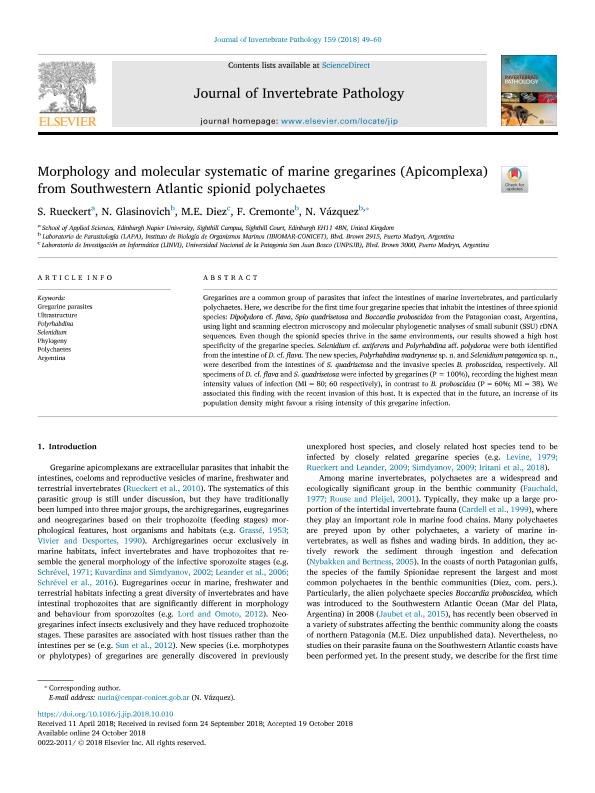Mostrar el registro sencillo del ítem
dc.contributor.author
Rueckert, S.
dc.contributor.author
Glasinovich, Natusha Irina

dc.contributor.author
Diez, María Emilia

dc.contributor.author
Cremonte, Florencia

dc.contributor.author
Vázquez, Nuria Natalia

dc.date.available
2019-12-12T20:03:46Z
dc.date.issued
2018-11
dc.identifier.citation
Rueckert, S.; Glasinovich, Natusha Irina; Diez, María Emilia; Cremonte, Florencia; Vázquez, Nuria Natalia; Morphology and molecular systematic of marine gregarines (Apicomplexa) from Southwestern Atlantic spionid polychaetes; Academic Press Inc Elsevier Science; Journal of Invertebrate Pathology; 159; 11-2018; 49-60
dc.identifier.issn
0022-2011
dc.identifier.uri
http://hdl.handle.net/11336/92129
dc.description.abstract
Gregarines are a common group of parasites that infect the intestines of marine invertebrates, and particularly polychaetes. Here, we describe for the first time four gregarine species that inhabit the intestines of three spionid species: Dipolydora cf. flava, Spio quadrisetosa and Boccardia proboscidea from the Patagonian coast, Argentina, using light and scanning electron microscopy and molecular phylogenetic analyses of small subunit (SSU) rDNA sequences. Even though the spionid species thrive in the same environments, our results showed a high host specificity of the gregarine species. Selenidium cf. axiferens and Polyrhabdina aff. polydorae were both identified from the intestine of D. cf. flava. The new species, Polyrhabdina madrynense sp. n. and Selenidium patagonica sp. n., were described from the intestines of S. quadrisetosa and the invasive species B. proboscidea, respectively. All specimens of D. cf. flava and S. quadrisetosa were infected by gregarines (P = 100%), recording the highest mean intensity values of infection (MI = 80; 60 respectively), in contrast to B. proboscidea (P = 60%; MI = 38). We associated this finding with the recent invasion of this host. It is expected that in the future, an increase of its population density might favour a rising intensity of this gregarine infection.
dc.format
application/pdf
dc.language.iso
eng
dc.publisher
Academic Press Inc Elsevier Science

dc.rights
info:eu-repo/semantics/openAccess
dc.rights.uri
https://creativecommons.org/licenses/by-nc-nd/2.5/ar/
dc.subject
ARGENTINA
dc.subject
GREGARINE PARASITES
dc.subject
PHYLOGENY
dc.subject
POLYCHAETES
dc.subject
POLYRHABDINA
dc.subject
SELENIDIUM
dc.subject
ULTRASTRUCTURE
dc.subject.classification
Zoología, Ornitología, Entomología, Etología

dc.subject.classification
Ciencias Biológicas

dc.subject.classification
CIENCIAS NATURALES Y EXACTAS

dc.title
Morphology and molecular systematic of marine gregarines (Apicomplexa) from Southwestern Atlantic spionid polychaetes
dc.type
info:eu-repo/semantics/article
dc.type
info:ar-repo/semantics/artículo
dc.type
info:eu-repo/semantics/publishedVersion
dc.date.updated
2019-10-22T15:45:10Z
dc.journal.volume
159
dc.journal.pagination
49-60
dc.journal.pais
Estados Unidos

dc.description.fil
Fil: Rueckert, S.. Edinburgh Napier University; Reino Unido
dc.description.fil
Fil: Glasinovich, Natusha Irina. Consejo Nacional de Investigaciones Científicas y Técnicas. Centro Científico Tecnológico Conicet - Centro Nacional Patagónico. Instituto de Biología de Organismos Marinos; Argentina
dc.description.fil
Fil: Diez, María Emilia. Universidad Nacional de la Patagonia "San Juan Bosco"; Argentina. Consejo Nacional de Investigaciones Científicas y Técnicas; Argentina
dc.description.fil
Fil: Cremonte, Florencia. Consejo Nacional de Investigaciones Científicas y Técnicas. Centro Científico Tecnológico Conicet - Centro Nacional Patagónico. Instituto de Biología de Organismos Marinos; Argentina
dc.description.fil
Fil: Vázquez, Nuria Natalia. Consejo Nacional de Investigaciones Científicas y Técnicas. Centro Científico Tecnológico Conicet - Centro Nacional Patagónico. Instituto de Biología de Organismos Marinos; Argentina
dc.journal.title
Journal of Invertebrate Pathology

dc.relation.alternativeid
info:eu-repo/semantics/altIdentifier/doi/https://doi.org/10.1016/j.jip.2018.10.010
dc.relation.alternativeid
info:eu-repo/semantics/altIdentifier/url/https://www.sciencedirect.com/science/article/pii/S0022201118301253
Archivos asociados
